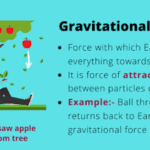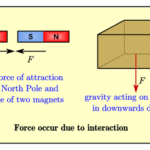In this article we will understand how to calculate work done by friction. Force of friction opposes motion of objects when they come into contact with each other. We also know that work done is equal to change in energy when force applied on a body displaces it. Here in this article we will discuss about calculating work done in case of frictional force.
Understanding Friction
As we know that friction opposes motion and it is caused by interaction between irregularities on the surface of objects in contact. Friction are of two types:
- Static friction: When an object is at rest, static friction prevents it from moving under the influence of an external force.
- Kinetic friction: Kinetic friction as the name suggests, comes into existence when the object is moving.
Friction can be described using the following equation:
$f_{f} = \mu f_{n}$
where,
$f_{f}$ is the force of friction
$\mu$ is the coefficent of friction. It can be static or kinetic.
$f_{n}$ is the normal force that acts on the object.
Calculating Work Done by Friction
Now that you know about friction let us look at the formula used for calculating the work done. Work done is given by formula
$W=Fd\cos(\theta)$
where,
$W$ is the work done
$d$ is the displacement
$\theta$ is the angle between force and displacement.
When calculating work done by friction, the force $F$ in the formula is replaced by the frictional force $(f_{f})$.
The angle between the frictional force and the displacement is always 180 degrees since friction always opposes motion.
Consequently, the formula for calculating work done by friction becomes:
$W_{f} = f_{f} d \cos(180^0)$
Since $\cos(180^0) = -1$, the formula simplifies to:
$W_{f} = – f_{f} d$
Step-by-Step Process to Calculate Work Done by Friction
- Finding the normal force $(f_n)$:
To calculate the frictional force, first you need to find the normal force acting on the object. For a horizontal surface, this is typically equal to the object’s weight (mass * acceleration due to gravity). - Find the coefficient of friction (μ):
This value is dependent on the materials of the two objects in contact and can typically be found in reference tables or textbooks. - Calculate the frictional force (f_friction):
Use the equation $f_f = \mu f_n$ to find the frictional force acting on the object. - Determine the displacement (d):
Measure or calculate the distance the object moves while being subjected to the frictional force. - Calculate work done by friction $(W_f)$:
Use the formula $W_f = -f_f d$ to find the work done by friction on the object.
Solved Example
A 10 kg box is being pulled along a horizontal surface with a constant force of 50 N. The coefficient of kinetic friction between the box and the surface is 0.3. The box moves a distance of 15 meters. Calculate the work done by friction.
Step-by-Step Solution:
- Determine the normal force (f_norm): Since the box is moving on a horizontal surface, the normal force is equal to its weight. The weight can be calculated using the formula $f_w = m g$, where m is the mass of the object and g is the acceleration due to gravity (approximately 9.81 m/s²).
$f_w = m g$
$f_w = 10 kg \times 9.81 m/s^2$
$ f_w = 98.1 N$
Thus, $f_norm = 98.1 N$. - Find the coefficient of friction (μ): The problem statement provides this value: μ = 0.3.
- Calculate the frictional force ($f_f$): Use the formula $f_f = \mu \times f_n$.
$f_f = μ f_n $
$f_f= 0.3 \times 98.1 N $
$f_f = 29.43 N$ - Determine the displacement (d): The problem statement provides the distance the box moves: d = 15 m.
- Calculate work done by friction (W_friction): Use the formula W_friction = -f_friction * d.
$W_f = -f_f d $
$W_f = -29.43 N \times 15 m $
$W_f = -441.45 J$
The work done by friction is $-441.45 J$.
In this example, we found that the work done by friction on the 10 kg box as it moves 15 meters along a horizontal surface is $-441.45 J$. The negative sign indicates that the work done by friction is in the opposite direction of the box’s motion, which is consistent with the fact that friction opposes movement.
Related Articles





